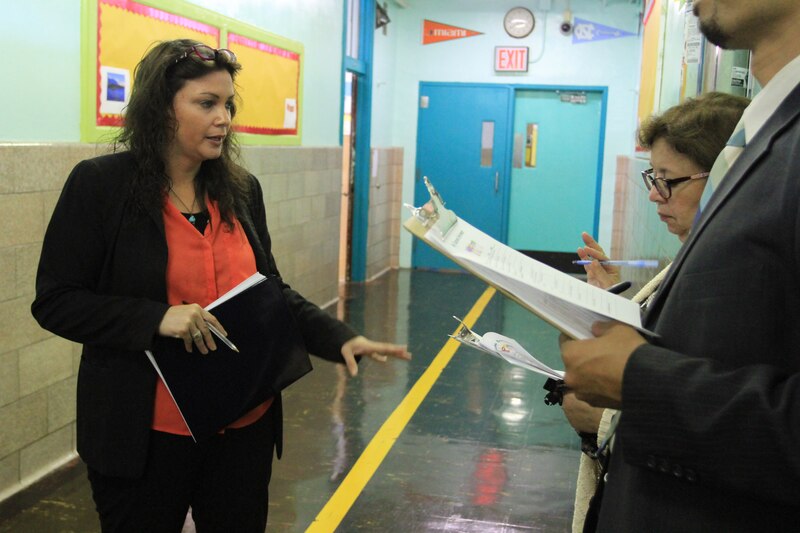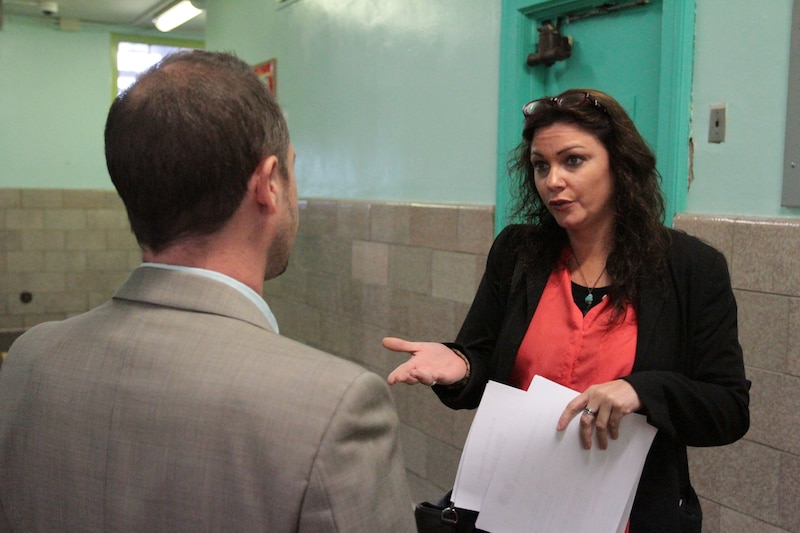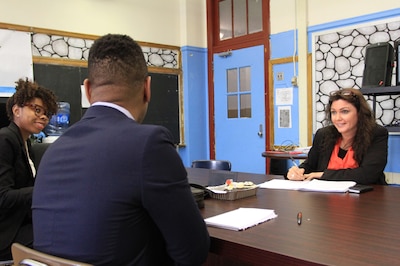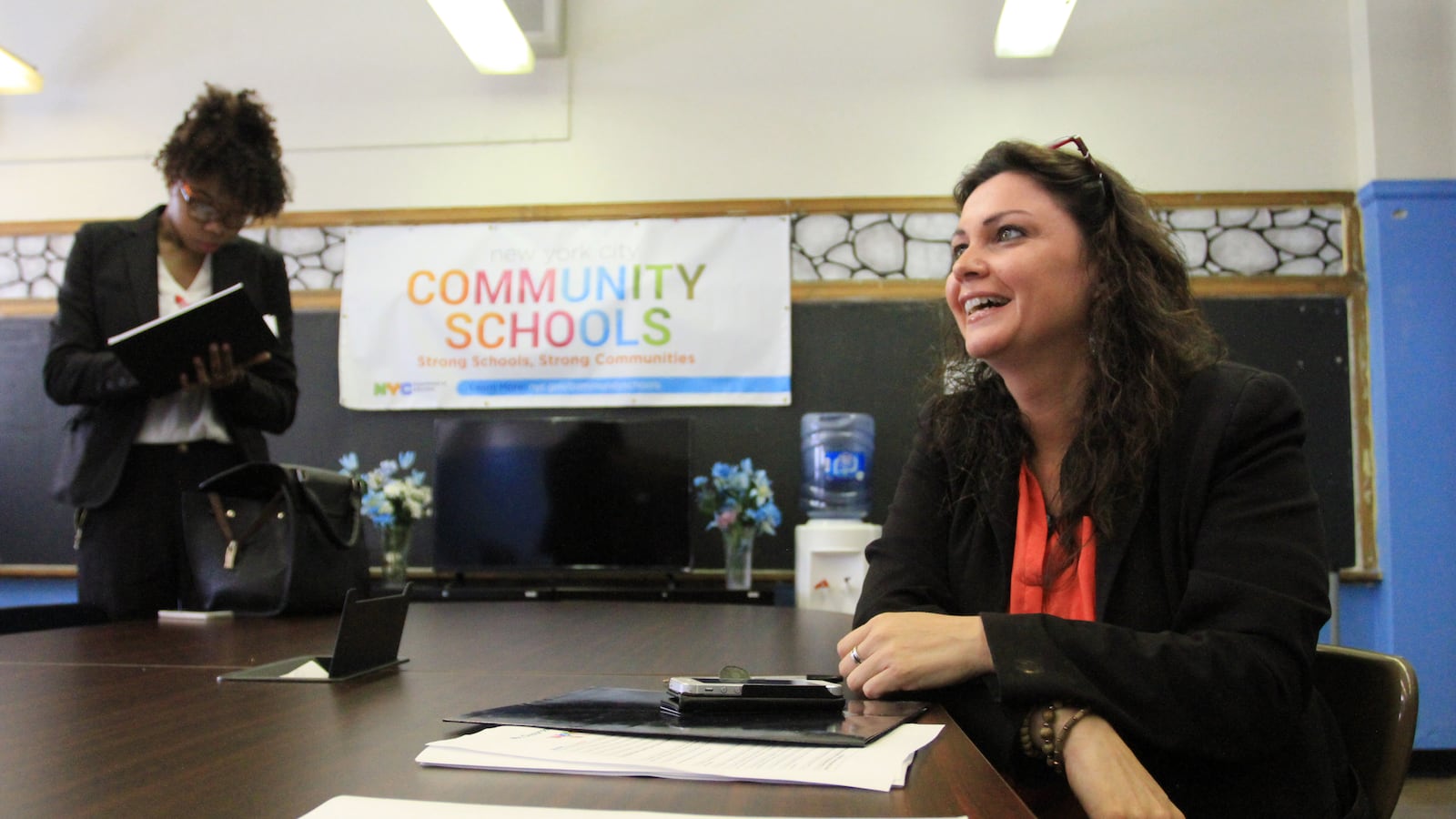As she roams the halls of the Richard R. Green middle school campus, she picks up stray pens on the way to evaluate a classroom and returns a student’s missing notebook before talking to principals about how best to use their extra teaching time.
Tasked with overseeing four long-struggling schools in the Bronx’s District 11 in the city’s “Renewal” school turnaround program, Rodriguez is trying to ensure they make academic progress and become more welcoming places for students and families. Since three of the schools share a building in the Williamsbridge neighborhood of the Bronx, walking the halls with her offers a concentrated glimpse at the challenges the schools face from the ground up — as she is making sure a student gets to class on time one minute and meeting with city officials the next.
Of all of those efforts, the one Rodriguez says is most critical is raising awareness in the neighborhood of the building’s new programs, including the mental health clinic on the way.
“It’s not the safest neighborhood in the Bronx, let’s put it that way,” she said, “so it’s turned a lot of people away from the campus and, potentially, students that we want to attract.”
That’s why Rodriguez turned to Chalkbeat’s Raise Your Hand series, asking, “How do you remove a long-standing negative reputation from a school? Are there examples of schools that have successfully done this?”
As we start digging into that question, we spent part of a school day with her at the Richard R. Green campus — which houses three Renewal schools: School of Diplomacy, Young Scholars Academy, and Globe School for Environmental Research.

First up: Meeting with staff of the building’s partner organization
Early in her day, Rodriguez checked in with the campus’s program director for Phipps Neighborhoods. Phipps is the community-based organization chosen by the three Renewal schools as the building’s official partner.
Rodriguez got a status update on several initiatives: vision screenings for all students, the creation of a new on-site mental health clinic, plans to bring a food pantry to the building for families, and a campus-wide “Halloween harvest festival” — complete with a haunted house.
She made her own suggestions, including starting a campus Facebook page, creating colorful pamphlets for each school to pass out to neighbors, and making sure local politicians were kept in the loop.
“My big job is to help market the campus inside and out,” she said. If the community doesn’t know what’s going on, she added, “They’re going to keep talking badly about the school.”
Even since the first day of school, changes in the building are visible. The black fencing surrounding the building is changing to a bright blue. Pumpkins and garlands of fall leaves line the entryway. College banners and bulletin boards decorate the halls, and new desks were being delivered this past week.
“We want to see kids coming to school more and their attendance going up, suspensions going down,” she said. “We want kids to go home and say, ‘I really like my school and I’m learning in my classroom.’”

Next up: Evaluating classrooms with assistant principals
Inside the classroom, it’s not just about hanging curtains and creating a friendly aesthetic. The Renewal initiative is also meant to improve academic instruction, and Rodriguez wants their classrooms to reflect the standards being set for the year.
On her way to meet with School of Diplomacy assistant principals to start “informal” classroom environment checks, Rodriguez ran into principal Sean Licata in the hall.
”Do the teachers know I’m coming?” she asked.
“No, but they’re used to you being here,” Licata said. “She lives here,” he added with a laugh.
With School of Diplomacy assistant principal Vivian Hernandez by her side, the pair visited a handful of classrooms to see how teachers had made progress on their room setup.
Their checklist asked: Does each classroom have a well-labeled independent reading library? Is the agenda for the day on the board? Are students being grouped by achievement level in ways that rely on data? Is high-quality student work displayed on the walls? Are student notebooks being checked for content and organization?
When teachers came up short, Rodriguez has armed with suggestions for assistant principals to pass along to their staffs.
“Kids need to be using those libraries. It doesn’t matter if it’s math class or science class,” she told Hernandez. “The chancellor is very big on that.”
On her way to the next classroom, Rodriguez was called back to the Phipps Neighborhoods office because its director has arrived to meet with her and a representative from the city’s community-schools office. It was still before noon.
“You’ll see I get interrupted a lot,” she said.
Rodriguez was still facing a full agenda of classroom visits, meeting with the Globe School principal to go over how the extra hour of daily instruction should be best used. She then needed to finalize a presentation for her fourth Renewal school, an elementary school in a different building, that is showcasing its progress at a meeting next week with Chancellor Carmen Fariña, the city’s Renewal elementary schools, and other department officials.
“We’re coming up with as much as we can come up with on our own to transform our school, but it would be great to see what other schools in other boroughs, what they’ve done to turn their schools around,” she said.
We want to hear from you: While

Rodriguez said she has been able to visit other Renewal schools to get ideas on how to move the campus forward, she said she doesn’t want to “be isolated in just the Renewal world” when it comes to turning around a school.
“Renewal schools are supposedly the most struggling ones, so we want to look at best practices and highly effective practices,” she said. “I want to know what else is happening in other boroughs, if there are any other schools outside of our own little community and district that we can actually tap into.”

